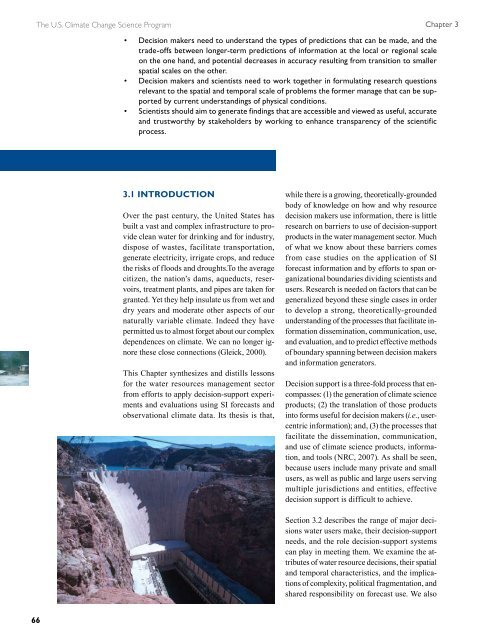Decision support experiments and evaluations using seasonal to ...
Decision support experiments and evaluations using seasonal to ...
Decision support experiments and evaluations using seasonal to ...
You also want an ePaper? Increase the reach of your titles
YUMPU automatically turns print PDFs into web optimized ePapers that Google loves.
The U.S. Climate Change Science Program Chapter 3<br />
66<br />
•<br />
•<br />
•<br />
<strong>Decision</strong> makers need <strong>to</strong> underst<strong>and</strong> the types of predictions that can be made, <strong>and</strong> the<br />
trade-offs between longer-term predictions of information at the local or regional scale<br />
on the one h<strong>and</strong>, <strong>and</strong> potential decreases in accuracy resulting from transition <strong>to</strong> smaller<br />
spatial scales on the other.<br />
<strong>Decision</strong> makers <strong>and</strong> scientists need <strong>to</strong> work <strong>to</strong>gether in formulating research questions<br />
relevant <strong>to</strong> the spatial <strong>and</strong> temporal scale of problems the former manage that can be <strong>support</strong>ed<br />
by current underst<strong>and</strong>ings of physical conditions.<br />
Scientists should aim <strong>to</strong> generate findings that are accessible <strong>and</strong> viewed as useful, accurate<br />
<strong>and</strong> trustworthy by stakeholders by working <strong>to</strong> enhance transparency of the scientific<br />
process.<br />
3.1 INTRODUCTION<br />
Over the past century, the United States has<br />
built a vast <strong>and</strong> complex infrastructure <strong>to</strong> provide<br />
clean water for drinking <strong>and</strong> for industry,<br />
dispose of wastes, facilitate transportation,<br />
generate electricity, irrigate crops, <strong>and</strong> reduce<br />
the risks of floods <strong>and</strong> droughts.To the average<br />
citizen, the nation’s dams, aqueducts, reservoirs,<br />
treatment plants, <strong>and</strong> pipes are taken for<br />
granted. Yet they help insulate us from wet <strong>and</strong><br />
dry years <strong>and</strong> moderate other aspects of our<br />
naturally variable climate. Indeed they have<br />
permitted us <strong>to</strong> almost forget about our complex<br />
dependences on climate. We can no longer ignore<br />
these close connections (Gleick, 2000).<br />
This Chapter synthesizes <strong>and</strong> distills lessons<br />
for the water resources management sec<strong>to</strong>r<br />
from efforts <strong>to</strong> apply decision-<strong>support</strong> <strong>experiments</strong><br />
<strong>and</strong> <strong>evaluations</strong> <strong>using</strong> SI forecasts <strong>and</strong><br />
observational climate data. Its thesis is that,<br />
while there is a growing, theoretically-grounded<br />
body of knowledge on how <strong>and</strong> why resource<br />
decision makers use information, there is little<br />
research on barriers <strong>to</strong> use of decision-<strong>support</strong><br />
products in the water management sec<strong>to</strong>r. Much<br />
of what we know about these barriers comes<br />
from case studies on the application of SI<br />
forecast information <strong>and</strong> by efforts <strong>to</strong> span organizational<br />
boundaries dividing scientists <strong>and</strong><br />
users. Research is needed on fac<strong>to</strong>rs that can be<br />
generalized beyond these single cases in order<br />
<strong>to</strong> develop a strong, theoretically-grounded<br />
underst<strong>and</strong>ing of the processes that facilitate information<br />
dissemination, communication, use,<br />
<strong>and</strong> evaluation, <strong>and</strong> <strong>to</strong> predict effective methods<br />
of boundary spanning between decision makers<br />
<strong>and</strong> information genera<strong>to</strong>rs.<br />
<strong>Decision</strong> <strong>support</strong> is a three-fold process that encompasses:<br />
(1) the generation of climate science<br />
products; (2) the translation of those products<br />
in<strong>to</strong> forms useful for decision makers (i.e., usercentric<br />
information); <strong>and</strong>, (3) the processes that<br />
facilitate the dissemination, communication,<br />
<strong>and</strong> use of climate science products, information,<br />
<strong>and</strong> <strong>to</strong>ols (NRC, 2007). As shall be seen,<br />
because users include many private <strong>and</strong> small<br />
users, as well as public <strong>and</strong> large users serving<br />
multiple jurisdictions <strong>and</strong> entities, effective<br />
decision <strong>support</strong> is difficult <strong>to</strong> achieve.<br />
Section 3.2 describes the range of major decisions<br />
water users make, their decision-<strong>support</strong><br />
needs, <strong>and</strong> the role decision-<strong>support</strong> systems<br />
can play in meeting them. We examine the attributes<br />
of water resource decisions, their spatial<br />
<strong>and</strong> temporal characteristics, <strong>and</strong> the implications<br />
of complexity, political fragmentation, <strong>and</strong><br />
shared responsibility on forecast use. We also




